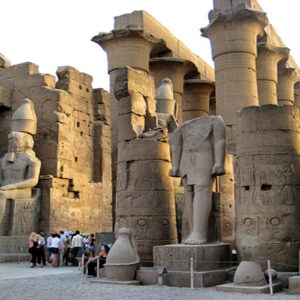King Tutankhamun's Tomb: An Icon of Egyptian Antiquities
Discovery of the Tomb:
In November 1922, British archaeologist Howard Carter made the world-shaking discovery of Tutankhamun’s tomb in the Valley of the Kings near Luxor, Egypt. This tomb, known as KV62, was remarkably intact, containing a treasure trove of artifacts that provided unprecedented insights into ancient Egyptian life and culture.
The Story of the Discovery:
For years, Carter had been searching for Tutankhamun’s tomb without success. Just when he was about to give up, a young Egyptian boy named Hussein Abd el-Rasoul stumbled upon the tomb’s entrance while digging a well. This fortuitous event led to one of the most significant archaeological discoveries in history.
The Tomb Treasures and Artifacts:
The tomb held an astonishing array of over 5,000 artifacts, including the iconic golden mask of Tutankhamun, which depicts the pharaoh as a divine being. These artifacts showcased the opulence and craftsmanship of the ancient Egyptian court, encompassing everything from jewelry and clothing to furniture, chariots, and weapons.
Mystery and Fame:
Despite his short reign of only nine years, Tutankhamun’s tomb has propelled him to become one of the most famous pharaohs. His story is intertwined with that of his father, Akhenaten, a controversial figure who attempted to introduce a radical new monotheistic religion. While Akhenaten’s reign was marred by turmoil, Tutankhamun’s restoration of traditional beliefs and the splendor of his tomb have ensured his enduring legacy.
Notable Artifacts from Tutankhamun’s Tomb:
Among the many treasures unearthed from Tutankhamun’s tomb, these stand out as particularly remarkable:
* The Pectoral of the Sun God: This exquisite pendant, adorned with precious stones and intricate designs, symbolizes the pharaoh’s divine connection to the sun god Ra.
* Statues of Tutankhamun and Deities of the Underworld: These 32 statues depict the pharaoh’s interactions with various gods and goddesses, offering a glimpse into ancient Egyptian beliefs about the afterlife.
* Golden Mask of Tutankhamun’s Mummy: Weighing an impressive 25 pounds, this iconic mask is a masterpiece of ancient Egyptian artistry and a symbol of Tutankhamun’s enduring fame.
* Elaborate Golden Sheath: This intricately crafted sheath once encased the pharaoh’s mummy, showcasing the exceptional craftsmanship of the time.
* Gilded Wooden Coffins: A series of nested coffins, culminating in the golden mask, protected the pharaoh’s mummy, reflecting the elaborate burial practices of ancient Egypt.
Tutankhamun’s tomb remains an unparalleled archaeological treasure, offering a window into the grandeur and mystique of ancient Egypt. Its discovery continues to captivate the world, solidifying Tutankhamun’s status as one of history’s most fascinating figures.
Egypt Tours to King Tutankhamun Tomb in Valley of the kings
-
From $1440 🎗 10% OFFAswan, Cairo, Egypt, Luxor

 Sale! Add to cart
7 Days Deluxe Nile cruise + Domestic Flights
Sale! Add to cart
7 Days Deluxe Nile cruise + Domestic Flights7 Days Tour To Egypt with Cairo, Aswan, Luxor, and Nile Cruise
Rated 0 out of 5Nile Cruise$2,000.00$1,600.007-Days Tour To Egypt with Cairo, Aswan, Luxor, and Nile Cruise Egypt Cruis Era provides you with a 7 days tour to Egypt that covers the essentials of Cairo, Aswan, Luxo -
Why you’ll love this trip: Enjoy a private 2-day trip to Luxor from Marsa Alam where you will visit the Luxor temple, Karnak temple, then check in 5* hot
-
Why you’ll love this trip: Explore all that Luxor has to offer on this comprehensive 2-day tour of the area. Visit key landmarks like the Valley of the
-
From $791 🎗 0% OFFAbu Simbel, Aswan, Cairo, Luxor

 Sale! Add to cart
2 Days Deluxe Nile cruise + Domestic Flights
Sale! Add to cart
2 Days Deluxe Nile cruise + Domestic Flights2 Day Aswan, Abu Simble and Luxor from Cairo
Rated 0 out of 5Egypt Tour Packages$3,500.00$2,800.00Why you’ll love this trip: Let a guide take care of planning your Egypt itinerary, in order to pack in as much in as possible, on a 2-day tour of Luxor an -
Why you’ll love this trip: Explore the great and historical upper Egypt portion including: Luxor, Danderrah and Abydous. See the Temple of Seti I and the Q












